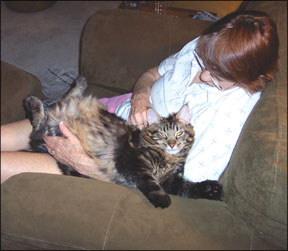When a cat forms a strong attachment to one fellow cat in the household while actively avoiding another, we chalk it up to personality preferences. As long as no one is injured, we do not complain. It is a cat of a different color, however, that fancies one human while consistently avoiding another family member.
Why should this happen? When a couple goes to a shelter to adopt a cat, they of course select one that appears friendly and

Bev Caldwell
288
interacts with both of them. Once the cat is brought home, both owners commonly take turns feeding, grooming, playing and snuggling with their new family member. Yet somehow, a cat may take to following only one member of the couple.
What is the reason for this biased bonding? Perhaps one person is loud or large in stature. The less-favored person may simply spend less time at home. There might even be a scent that disturbs the new adoptee.
The reason for particular preferences may never be understood completely. But can we do anything about it? Can we convince a cat to befriend someone?
Unfortunately, the first reaction of the shunned partner is usually to try harder. It is only natural to try to encourage or even force the new cat to sit nearby. Attempts to reach for, lift or even lure a cat with food are likely to drive her farther away. When the person becomes frustrated by his failed attempts, the cat is likely to become frightened. When cats detect that something is wrong, they depart.
Think about these efforts for a moment and it will be clear why these well-meaning gestures typically backfire. The cat in question has inexplicably decided that she had best keep a distance from a certain person. She has attempted to maintain a comfortable distance, yet the determined person pushes in. This invasion of space is disturbing to the cat. So off she runs. Running serves to reinforce fear, and the cat has no opportunity to relax and learn that she was really safe.
What You Can Do
Here is a good example of where a “less is more” strategy will pay off. The first step is to cease all efforts to coax and lure. The second step is to prevent the cat from running off in fear.
Set up a safe vantage point by using a cat condo or by placing a fleece pad on a counter or sturdy shelf that has been cleared of valuables. Once the irresistible spot has become a favored resting place, set a dish of tasty food somewhere between your own resting place and hers. Sit quietly – this training should be done while you relax, read or watch a movie. No cheering for sports, no tangos. Your kitty must feel comfortable enough to eat and then return to her safe place.
After a few sessions, she will be more at ease getting the food. While eating, she is learning about you. Once she is eating nicely, place the dish closer to your own seat. With each successful session, bring the food closer until you are close enough to add extra morsels to the dish while sitting in your chair.
Sit quietly beside her. No coaxing or reaching. She may attempt to solicit more food. Quietly speak to her as you drop the morsels into the dish. Next, add some eye contact and finally, brush your hand against her as you drop the food into the dish. If she chooses to rest beside you, then try tossing a toy or luring her with a wand toy before you move. Remember, we dont want her to rush off in fear.
Carry treats or toys and toss them when you move about the house. If you pass by her when she is resting, drop a treat and move on. Work your way up to placing the treat directly in front of her, and finally, handing it to her. At this point, try giving the treat and then a gentle stroke before moving on.
Work slowly to teach your cat that your gestures are well-meaning. If she reaches to you, reach back ever so lightly so that she does not pull away. Learn about the things that she finds rewarding, and become the main source of those resources.
Will she treat both members of the couple equally? Maybe not. Personalities are personalities. But at least she can learn that both of her people are safe to be with. Each person has his purpose.



